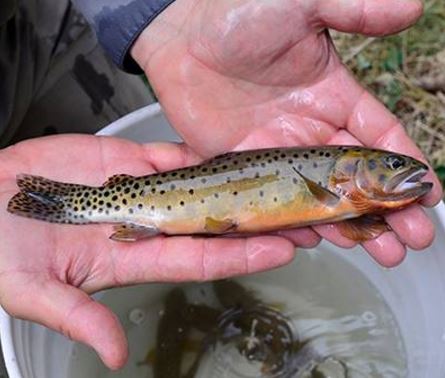Grants Benefiting Native Trout Watersheds Awarded in Six Western States

The Western Native Trout Initiative (WTNI) is awarding more than $200,000 in grant funding for eight projects benefiting native trout species across the West.
The Western Native Trout Initiative (WTNI) is awarding more than $200,000 in grant funding for eight projects benefiting native trout species across the West.
The Western Native Trout Initiative (WNTI) is awarding more than $200,000 in grant funding for eight projects that benefit native trout species across the western United States. The community-based projects are funded through the National Fish Habitat Action Plan and the U.S. Fish and Wildlife Service. The projects were selected because of their emphasis on collaborative action to address some of the biggest challenges facing the restoration and recovery of western native trout.
“The main objective of the Western Native Trout Initiative is to leverage and catalyze strategic, local efforts that stabilize, recover and improve populations of western native trout. In addition to the grant funding we’re providing through the National Fish Habitat Partnership, local partners have secured additional matching funds totaling $2.186 million dollars for these projects.”
WNTI Coordinator Therese Thompson
The following native trout habitat projects have been approved for funding by WNTI for 2019:
COLORADO – Restore Sand Creek to a Native Rio Grande Cutthroat Fishery
This project will reclaim high quality stream and lake habitat to provide a resilient watershed for the reintroduction of native Rio Grande Cutthroat Trout within its historic range within Great Sand Dunes National Park. Completion of the project will add 12 miles and two lakes of habitat for Rio Grande Cutthroat Trout. The lead partner is the National Park Service.
IDAHO/WYOMING: Tincup Creek Stream Restoration Project, Phase 3
This is the third phase of a project to improve four miles of ecosystem function and riparian and instream habitat for Yellowstone Cutthroat Trout, northern leatherside chub, boreal toad, Western pearlshell mussel and bluehead sucker. The lead partner is Trout Unlimited.
MONTANA: Selway Meadows Westslope Cutthroat Trout Population Restoration
This project will install a fish barrier to allow for re-establishment of a genetically diverse and unaltered aboriginal Westslope Cutthroat Trout population of over 25,000 individuals in 48 miles of river upstream of the barrier. Project activities also benefit Western pearlshell mussel and result in an intact native aquatic assemblage in a publicly accessible drainage. The lead partner is Montana Fish, Wildlife and Parks.
MONTANA: Wall Creek Fish Barrier
The purpose of this project is to protect approximately eight miles of habitat occupied by genetically pure Westslope Cutthroat Trout by constructing a fish passage barrier on public lands in the Wall Creek drainage, tributary to the Madison River. Project activities also benefit Mottled Sculpin and Arctic Grayling. The lead partner is the U.S. Forest Service.
MONTANA: Yaak Headwaters Restoration Partnership Project
This project benefits Westslope Cutthroat Trout, Bull Trout, and Interior Redband Trout by active and passive decommissioning of 5.1 miles of unneeded road, including removal of two culverts that are acting as barriers to fish passage, in the Yaak River watershed in northwest Montana. The lead partner is the Yaak Valley Forest Council.
NEW MEXICO: Santa Clara Creek – Headwaters Restoration
The project objective is to maximize ecosystem potential for sustaining a prime, cold-water native fishery that is resilient to variable flow rates from drought and flood events. This project restores habitat to benefit Rio Grande Cutthroat Trout on the Santa Clara Pueblo tribal lands, impacted by the catastrophic Las Conchas wildfire in 2011. The lead partner is the Santa Clara Pueblo Department of Forestry.
OREGON: Central Oregon Interior Redband Genetic Status Project
The project will determine the genetic status of Columbia River Basin Interior Redband Trout populations in Central Oregon within the Tumalo Creek and South Fork Crooked River watersheds. Determining the status is critically important for the management and conservation of this species, which is classified as a sensitive species with the Forest Service, BLM, and the State of Oregon. The lead partner is the U.S. Forest Service.
OREGON: Deep Creek Floodplain Restoration Project – Phase 2
The Lower Deep Creek Floodplain Restoration Project (Phase 2) is a continuation of in-stream and riparian restoration activities that were implemented in 2018 (Phase 1) to improve a state 303(d) listed impaired water. The primary objective of the project is to improve the overall watershed health of Lower Deep Creek by reconnecting surface and subsurface flows to an elevation near the historic floodplain, thus restoring stream function and improving native Interior Redband Trout and other aquatic organism habitat. The lead partner is the U.S. Forest Service.
WNTI is an initiative of the Western Association of Fish and Wildlife Agencies that seeks to cooperatively restore and recover 21 western native trout and char species across their historic range. Since its inception in 2006, WNTI has directed $35 million in federal, public and private funds to support 147 priority native trout conservation projects. WNTI and partners have removed 96 barriers to fish passage, reconnected or improved 1,199 miles of native trout habitat and put in place 35 protective fish barriers to conserve important native trout populations.
For more information about these projects, visit https://westernnativetrout.org/2019-funded-projects/
Posted by WAFWA at 9/16/2019
Comments (0)